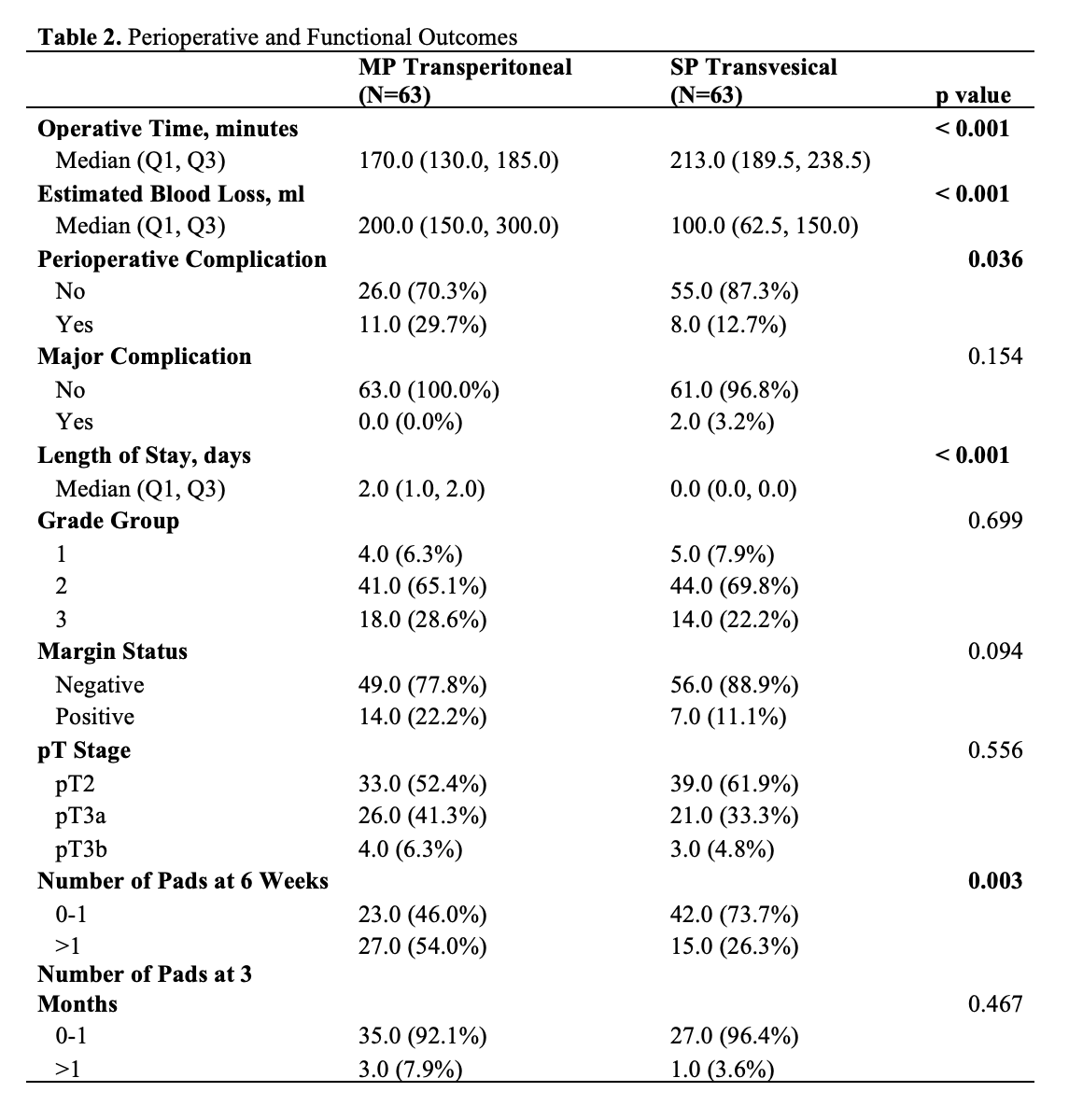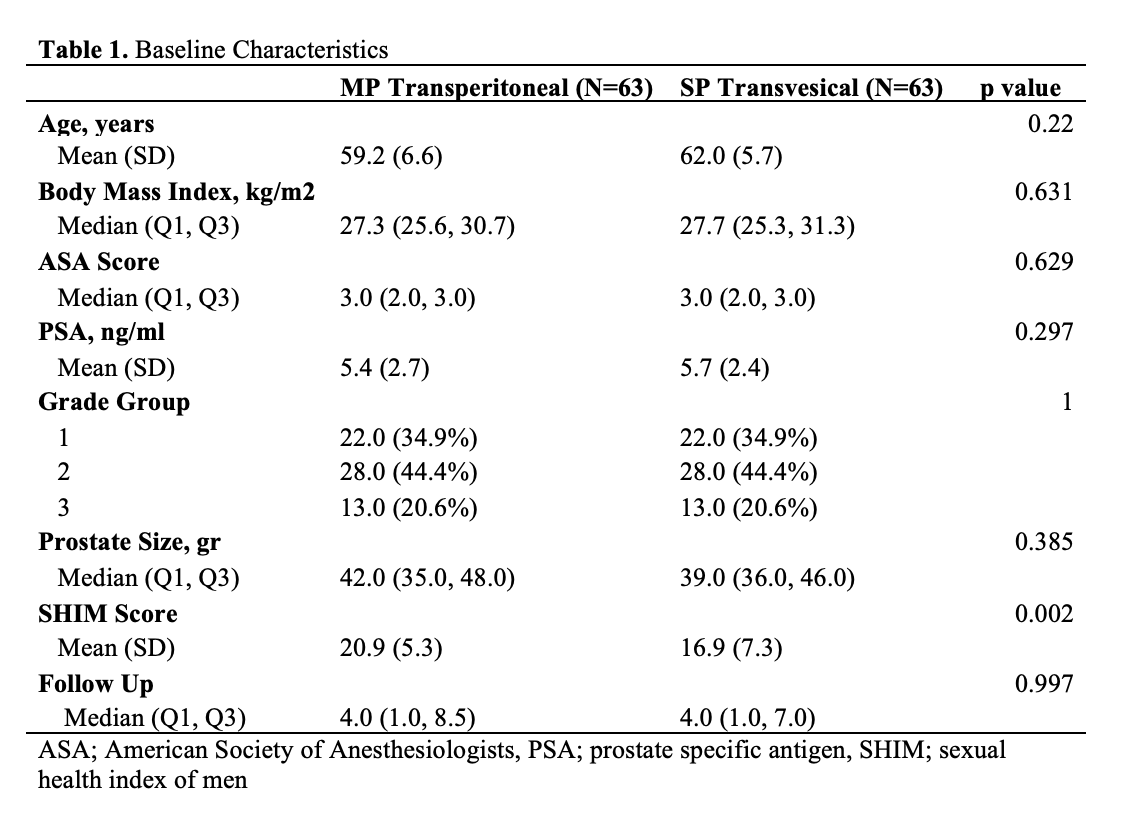Back
Poster, Podium & Video Sessions
Moderated Poster
MP57: Prostate Cancer: Localized: Surgical Therapy IV
MP57-09: Comparison of Perioperative and Short-Term Functional Outcomes Between Single-Port Transvesical and Multi-Port Transperitoneal Robotic Radical Prostatectomy
Monday, May 16, 2022
10:30 AM – 11:45 AM
Location: Room 225
Alp Tuna Beksac*, Mahmoud Abou Zeinab, Aaron Kaviani, Ethan Ferguson, Jihad Kaouk, Cleveland, OH

Alp Tuna Beksac, MD
Fellow
Cleveland Clinic, Glickman Urological & Kidney Institute
Poster Presenter(s)
Introduction: Single-port transvesical radical prostatectomy (TVRP) is a novel way to treat localized prostate cancer with promising early continence recovery. In this study, we sought to compare the perioperative and early functional outcomes of TVRP with the gold standard transperitoneal multi-port robotic radical prostatectomy (MPRP).
Methods: From a prospectively maintained single-center series, we performed a 1:1 matched-pair analysis of 126 patients who underwent radical prostatectomy. Patients in the MPRP group underwent surgery prior to 2018, whereas patients in the TVRP group underwent surgery after 2018. This was done to avoid selection bias. Cohorts were matched for Gleason score, PSA, and prostate size. Perioperative and functional outcomes were compared using using, chi-square, Fisher’s exact, Mann Whitney U and t-tests.
Results: After matching, baseline characteristics were all comparable between the two groups. The median total operative time was longer in the TVRP group (213 vs 170 min, p<0.001). Median estimated blood loss was less (100 vs. 200 ml, p<0.001) and length of stay was shorter (0 vs. 2 days, p<0.001) in the TVRP group. Positive surgical margin rates (11.1% vs. 22.2%, p=0.094) were comparable. Overall complication rate was lower in TVRP group (29.7% vs. 12.7%, p=0.036) Two major complications in the TVRP group were lymphocele and pelvic hematoma. TVRP resulted in improved continence at postoperative 6 weeks (73.7% vs. 46%, p=0.003). Continence rate was comparable at postoperative 3 months (96.4% vs. 92.1%, p=0.467).
Conclusions: TVRP is an alternative approach to MRP. In our initial series, TVRP allowed faster recovery of urine continence without compromising margin rates or perioperative outcomes.
Source of Funding: None


Methods: From a prospectively maintained single-center series, we performed a 1:1 matched-pair analysis of 126 patients who underwent radical prostatectomy. Patients in the MPRP group underwent surgery prior to 2018, whereas patients in the TVRP group underwent surgery after 2018. This was done to avoid selection bias. Cohorts were matched for Gleason score, PSA, and prostate size. Perioperative and functional outcomes were compared using using, chi-square, Fisher’s exact, Mann Whitney U and t-tests.
Results: After matching, baseline characteristics were all comparable between the two groups. The median total operative time was longer in the TVRP group (213 vs 170 min, p<0.001). Median estimated blood loss was less (100 vs. 200 ml, p<0.001) and length of stay was shorter (0 vs. 2 days, p<0.001) in the TVRP group. Positive surgical margin rates (11.1% vs. 22.2%, p=0.094) were comparable. Overall complication rate was lower in TVRP group (29.7% vs. 12.7%, p=0.036) Two major complications in the TVRP group were lymphocele and pelvic hematoma. TVRP resulted in improved continence at postoperative 6 weeks (73.7% vs. 46%, p=0.003). Continence rate was comparable at postoperative 3 months (96.4% vs. 92.1%, p=0.467).
Conclusions: TVRP is an alternative approach to MRP. In our initial series, TVRP allowed faster recovery of urine continence without compromising margin rates or perioperative outcomes.
Source of Funding: None



.jpg)
.jpg)